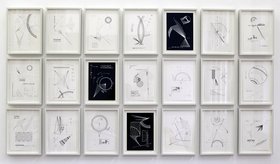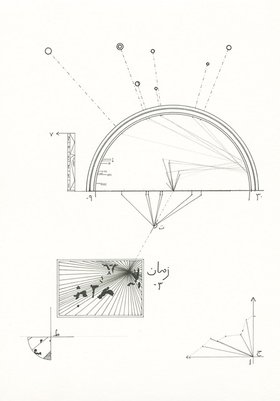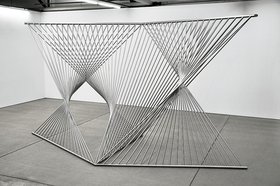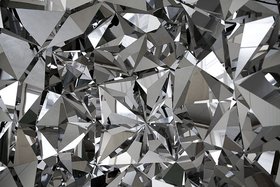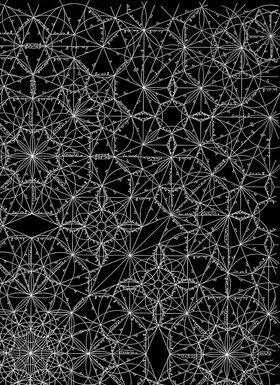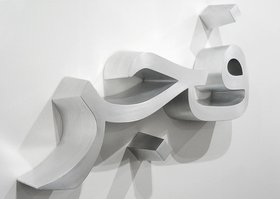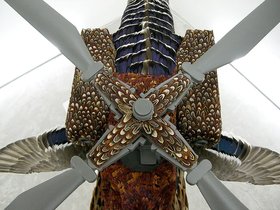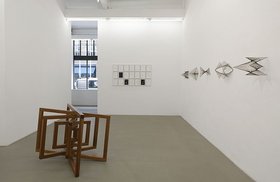Interviews
An Architecture of Apprehension
Timo Nasseri in conversation with Laura Allsop
Berlin-based artist Timo Nasseri explores language – be it mathematical, Farsi or, indeed, military – in his drawings and installation work. Starting out as a commercial photographer, Nasseri began making art works with a series of photographs and tactile sculptures of war machines that investigated both the insidious poetics of military nomenclature and the seductive packaging of weapons. Since then, he has taken inspiration from ostensibly diverse subjects as geometry, mathematics, and Islamic ornamentation in drawings and sculptures that underline their interconnectedness in terms of repetition and aesthetics. In this conversation with Ibraaz's Laura Allsop, Nasseri talks about his most recent body of drawings, inspired by a short story by Jorge Luis Borges. Composed of triangles that could, in his words, be 'an explanation for how everything works in a different universe, [or] how to find something in a parallel world', the drawings engage with a variety of ideas including, but not necessarily related, material such as the religious significance of muqarnas – a corbel or a decorative ornament normally found in Islamic architecture – and many-worlds theory.
Laura Allsop: You have a solo show opening at Sfeir-Semler gallery in Hamburg this month, with a title taken from a Jorge Luis Borges short story. Can you tell me about the work you will show?
Timo Nasseri: The new show is called O time thy pyramids, which is a quote from a story by Jorge Luis Borges, called The Library of Babel, which deals with different ideas of infinity, language and readability. It's not really a story, more a description of a mathematically infinite world that is this library, a hexagonic comb-like building that is packed with books. In this world, there is something like an alphabet made up of 25 symbols that we can call letters and they are in every possible combination but that don't lead to words that we would understand. So the inhabitants of this world are looking through this library all the time, looking for something that explains everything in this cacophony. And finally, there is one sign that might show that it is all about something, and this occurs in one of the last pages of one book, where one finds the sentence 'O time, thy pyramids'. At that point, the [characters] are trying to rethink the legibility of these books and consider that even though they may not understand them, every word and every combination of letters might mean something in a different world, or a parallel universe. So it points not just towards ideas about the infinite but also the idea of quantum mechanics, an alternative reality. There is a part of quantum theory called many-worlds theory that states that there are many universes coexisting, ones that might be very close to ours, whereby we are not talking via skype, for instance, but on the phone. And it's happening somehow now. I started a drawing series called One and One a couple of years ago with white ink on black paper. They are very mathematical – they are based on formulae, a combination of triangles that lead to an ornament, actually the base of Islamic pattern ornaments. All the formulae and circles in these drawings are there to construct and describe the triangles, the length of the sides and its angles. It's about the construction of patterns that lead to certain architectural elements like muqarnas and how a special aesthetic is based on mathematics, repetition, a certain kind of rhythm. This is something very real, it exists here, it leads to endless possibilities for combining these elements in these drawings, so you have an infinite amount of ornaments. One part of the exhibition is a new series of little drawings appearing to be very mathematical – indeed they are mathematical, very geometrical and bring together certain things from mathematics, from mapping. They may remind you on some level of other things – but they are not readable. That means we can read the numbers on it, find things that look familiar, whether geometrical or from nautical charts, but somehow it all makes no sense even though there comes something mystical or arcane with them that draws our attention. The idea is that in fact they are an explanation, maybe for how everything works in a different universe, for how to find something in a parallel world, or even how our world can be seen from another point of view. So it's kind of a fantastical world, inspired by Borges. I will show over 60 of these small drawings.
LA: You mentioned readability, and that there's an obsessive quality to these works. I'm interested in the idea of mathematics as a universal language and of art being, in some ways, through its visual aspect, a universal language as well. I wondered if there is a connection there in your work?
TN: I think there are similarities. To a certain degree, you can learn to read both. If you had a stock amount of information about art you could learn to read it or put it in an art historical context. It's kind of the same in mathematics. We all did it in school and were somehow able to use its language to a certain degree. But there is a point in mathematics where you need a gift to think mathematically beyond what we learned at school. There are always special problems and questions in the history of maths that are unsolved, and there are people who come along that can somehow solve them even though others have tried for years, sometimes untrained people who have a gift. I think that learning and talking about art is one thing. But what we can't really do anymore is let go and stand in front of something that we might not understand in the beginning and – this sounds terrible – open ourselves to it, give ourselves the time to let it talk to us. You go to exhibitions and you stand in front of something and get the feeling right away that you don't understand the piece. If you would allow yourself in every exhibition just three or four minutes without reading a description and try to let it do something to you, it would change something.
LA: This touches on this notion of legibility, which is interesting, because some of your wall-based and calligraphic works are in Farsi. So having these text-based works in a language that some of your viewers can understand but some can't, relates to this idea of readability, of who can read and who can't, and about appreciating an artwork without having to read a particular language – be it an actual foreign language or art critical language, for example.
TN: I'm half Iranian, that's true, but I can't speak or write Farsi. I try to develop these tempting, seductive sculptures that you want to touch, that seem to be drawn from the world of advertising, that are glossy and glamorous. The calligraphies are all certain Farsi words, like 'falling star', 'dawn', 'first light of the day' and so on. In fact they are all names of Iranian weapons systems, mainly missiles. Their poetic names and pleasing shapes speak nothing of the destruction they otherwise evoke. So this work is about giving certain attributes to weapons. I started a photo series called JETSKIN on war planes in 2003 and did a lot of research into military aircraft. I found that a lot of American warplanes have Native American names, like Apache, Comanche, Black Hawk and so on, which I thought was so weird because the American military at that time was engaged in trying to wipe out all of the Native Americans. But 100 years later they take their attributes, linked to their names, and put them on their military aircrafts. Then I was looking for similarities in other countries, and I found out about these weapons systems in Iran. Every name for these missiles sounded like something from heaven. This makes a big difference in communication – if you communicate to your own people names like 'falling star' or 'first light of day', it's so different than if you just give the weapons systems numbers. Initially someone must have asked the question, how do we communicate war? How can we make this whole thing attractive? This first series of photos of planes started during the second Iraq war, when I was watching TV at night and there were all these images of American military aircrafts, and everything was so glamorous and shiny and clean and tempting that at one point, I was just so curious that I had to delve into this strange thing where you want to touch it and adore it and then you go home and you think about it, and you wonder, what actually makes a good fighter?
LA: You mentioned earlier that maths isn't your strength, also that you don't speak Farsi. I'm interested that you don't speak these languages that you use in your works – what's it like to appropriate these languages, how do you negotiate them? For example, Gon, your work for the Abraaj Capital Art Prize in 2011, was constructed using mathematical formulae and I wondered how you used these formulae, how you worked them out?
TN: This is a pretty good example, and the development of Gon is kind of similar to the drawings and my Muqarnas series. The muqarnas are in fact based on the One and One drawings, which function as a structural design. The drawing is a two-dimensional structure and the muqarnas is the same structure translated to the third dimension under certain parameters. With the Gon piece, it's the same. I found a drawing by a Swiss mathematician from the 19th century called Jakob Steiner. He used to teach in Berlin and I didn't know anything about him and found the drawing by chance. It simply showed how a parabola can be constructed by only using straight lines. He was trying to explain and solve this mathematical problem with geometry, with drawings. This was very familiar to me, because I'm someone who tries to figure things out by seeing and drawing them. I like the idea that drawings can solve problems. My idea was to translate a drawing like that into three dimensional space like I did with the muqarnas. I chose a very basic form, a rhombus, and was trying to find out how I could divide it. I was experimenting, trying lots of different things, and built little models and started doing these with wires. Then once I had finished it as a model I started to learn a 3D programme on the computer and built the whole thing using it. So you can find in this work certain mathematical formulae but they weren't the basis, I didn't construct it after mathematical formulae or calculations, I just used certain formulae and techniques to create this work.
LA: And what drew you to make a series of works around the muqarnas? Is there a link between the very beautiful and precision-designed war machines that you talked about before, and something like a muqarnas, which is a very aesthetically pleasing feat of engineering and design?
TN: The only link is that I was very curious about both. The muqarnas thing started much earlier. A muqarnas is an element in Islamic architecture that normally occurs in the entrances to mosques, usually beneath an arch or a vault. I was travelling with my father to Iran in 1997 and visiting all these places and I was confronted with muqarnas, which look like hollowed-out honeycombs in the ceiling, with these blue tiles – very ornamental. And I wanted to know the system behind it – was it mathematical, did it come from a drawing, where did it come from, and how was it done? It was obvious that there was a system behind it but I couldn't figure it out. In the following years I did a lot of travelling along the Silk Route and I was so struck by this architectural element that at one point I decided I had to find out how they worked. So I did some research and came across this thesis about reconstructing broken muqarnas. I found that there is a very logical mathematical basis behind it. The process was somewhat similar to the war planes work, where I really wanted to get to the core of things. What's the base of it, what's behind the first glance? It's not that I'm sitting there and thinking I should really make something about muqarnas or maths, it comes by chance. I see something, and I see it over and over again, and I want to find out more .
LA: That brings me back to what we were talking about earlier, the obsessive quality to your process, the focus on repetition, and the way that the muqarnas and the drawings seemingly refer back to the notion of infinity.
TN: Thinking about the meditative quality of repetition came when I started working on the Muqarnas series. I realised that the construction of these ornamental patterns follows certain rhythmical repetitions and the act of drawing them becomes a meditation. The drawings are a good example. They are very geometrical and very clear and I know where I have to go. One thing I have to explain about the drawings is that they're made from a combination of triangles; in fact it's only four different triangles, which are always repeating all the time and can carry on forever. The end of the drawing is only determined by the piece of paper. All of the One and One drawings could continue endlessly. This is why the lines don't go to the end of the paper and I'm leaving a bit of black, so it's clear there is the possibility for more. Aesthetics is very much linked to repetition. There is a mathematician called Scott Rickard who tried to compose the worst piece of music ever written by repeating nothing, neither the length of a note, nor a single note itself. He used all the 88 keys on the piano and by not repeating the length of a note, there was no rhythm left. Repetition is very important when it comes to a normal aesthetic. If you listen to a song without repetition, it would just sound very odd. Rhythm is itself repetition. Little changes, variations in this repetition, can make things interesting.
LA: The meditative nature of these repetitions – could you elaborate? Is there a religious aspect to it?
TN: I'm not religious and my father wasn't either, but what I know is that there are certain elements in the muqarnas that for example the Sufists give a deeper meaning to. In the muqarnas, there is a very basic form in the centre which is meant to symbolise the alliance of heaven and earth. The centre is usually a double square, with a symbol for earth (a square) and heaven (a rhombus, a square rotated by 45 degrees). So if you combine these two, you get a star. Obviously, muqarnas are part of the ceiling. So it's about looking up to something superior and sublime. I decided I wanted mine as a reflection on eye-level. I decided to use mirrors so that it's reflecting itself and its surroundings in a different way. When you stand in front of one of these sculptures, you look into 400 to 600 mirrors, but you don't see yourself, because the angle of the mirrors means that you only see fragments of the surrounding room that you can't really locate. Up is down. But you never really see yourself except if you get very, very close and even then you will see only a fragment of yourself. This links to the idea of aniconism, of not showing pictures of sentient living beings – even though I like the idea that you can't make a picture via one image.
LA: I wanted to ask about your beginnings as an artist, because you mentioned earlier that you started out as a photographer. And I wonder what made you want to change direction, leave photography and make artworks instead?
TN: I started off as a commercial photographer for magazines after graduating from photo school. After three or four years I decided I was just tired of that world. You put so much effort and energy into every photo and you end up with your work in a magazine, which maybe 20,000 people buy and look at and then a week later, they throw away. When I was studying photography, I was already more interested in ideas, in photography as an art form rather than a service. In 2001, I decided that I had to at least try to make photography as art. I started doing sculptures after being invited by my gallery to take part in a group show. They asked me if I wanted to do anything with the gallery. An idea popped up, and it didn't make sense as a photograph so I thought I would give it a try. When I started this object, I realised immediately that this was something I really wanted to do. I wanted to be closer to what I was doing, have more contact. In photography you spend more than 90 percent of your time preparing things, at the computer or in the lab. So from the moment I did this first sculptural piece, something switched in me. What happened was that every idea that I had from that moment on was sculptural and I had no more photo ideas, everything was 3D. And so I got stuck onto sculpture. Four years later, I started drawing.
LA: Previously where you mentioned that your wall sculptures in Farsi have a high gloss finish to them, and also the warplanes having this problematic sense of glamour to them, I wonder if when you were working on these series you were drawing on your past as a commercial photographer and that high-gloss world? Is there a link between those two phases of your career?
TN: That's an interesting question, I am not sure. I'm always trying to go for the material that fits the piece. The glossy surfaces of my objects caused me so much trouble in terms of production and maintenance that sometimes I wish I could just change the material. But it has to fit the work. To get back to your question, yes, when it comes to the calligraphy works, it's true, they were meant to look like an advert – tempting, seductive, glossy, a little over the top.
Timo Nasseri was born and is based in Berlin. He worked as a photographer before becoming an artist and has since held solo shows at Sfeir-Semler gallery in Hamburg and Schleicher+Lange in Paris. He was a 2011 recipient of the Abraaj Capital Art Prize.

